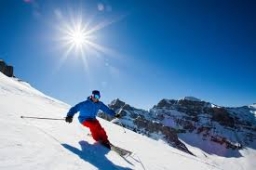Inclination of a hill
A skier starts down a hill of length l and an angle of inclination of 10˚. It then moves to a horizontal section of the track, which travels the same length l until it stops.
Determine the coefficient of sliding friction between the skis and the snow.
Determine the coefficient of sliding friction between the skis and the snow.
Final Answer:

Tips for related online calculators
Do you want to convert velocity (speed) units?
See also our right triangle calculator.
See also our trigonometric triangle calculator.
Try conversion angle units angle degrees, minutes, seconds, radians, grads.
See also our right triangle calculator.
See also our trigonometric triangle calculator.
Try conversion angle units angle degrees, minutes, seconds, radians, grads.
You need to know the following knowledge to solve this word math problem:
planimetricsgoniometry and trigonometryUnits of physical quantitiesthemes, topicsGrade of the word problem
We encourage you to watch this tutorial video on this math problem: video1
Related math problems and questions:
- Coefficient 80515
 A tractor pulls a tree trunk weighing 1.5 t for a distance of 2 km along a horizontal road at a constant speed. What mechanical work does it do if the coefficient of sliding friction is 0.6?
A tractor pulls a tree trunk weighing 1.5 t for a distance of 2 km along a horizontal road at a constant speed. What mechanical work does it do if the coefficient of sliding friction is 0.6? - Half-circles 81731
 A skier skis down a black slope. He makes a total of 31 half-circles while going down the hill. The radius of one semicircle is 4m. What distance did he travel?
A skier skis down a black slope. He makes a total of 31 half-circles while going down the hill. The radius of one semicircle is 4m. What distance did he travel? - Calculate
 A bicycle rotates with a frequency of f= 25 Hz. By braking, its rotation can be slowed down evenly and the bicycle stops after a time of t0= 30 s from the start of braking. Calculate the angular acceleration Ԑ and the number of revolutions the bicycle mak
A bicycle rotates with a frequency of f= 25 Hz. By braking, its rotation can be slowed down evenly and the bicycle stops after a time of t0= 30 s from the start of braking. Calculate the angular acceleration Ԑ and the number of revolutions the bicycle mak - Friction coefficient
 What is the weight of a car when it moves on a horizontal road at a speed of v = 50 km/h at engine power P = 7 kW? The friction coefficient is 0.07
What is the weight of a car when it moves on a horizontal road at a speed of v = 50 km/h at engine power P = 7 kW? The friction coefficient is 0.07 - Coefficient of friction
 A car moves along a horizontal road at a speed of 15 m/s. After turning off the engine, the car traveled a distance of 225 m. What was the coefficient of friction for this motion?
A car moves along a horizontal road at a speed of 15 m/s. After turning off the engine, the car traveled a distance of 225 m. What was the coefficient of friction for this motion? - Shear friction
 How much force must we apply to a box weighing 300 kg to move it uniformly along a horizontal floor if the coefficient of shear friction between the box's edge and the floor is 0.5?
How much force must we apply to a box weighing 300 kg to move it uniformly along a horizontal floor if the coefficient of shear friction between the box's edge and the floor is 0.5? - AMSL and skiing
 Tomas skis from point A (3200m above sea level) to place B. The Hill has a 20% descent. The horizontal distance between the start and finish is 2.5 km. At what altitude is point B?
Tomas skis from point A (3200m above sea level) to place B. The Hill has a 20% descent. The horizontal distance between the start and finish is 2.5 km. At what altitude is point B?
